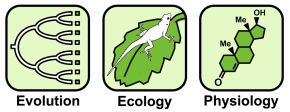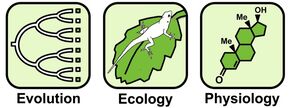Sperm evolution
Sperm are the most variable cell type found in animals, but we know relatively little about how this cellular diversity has arisen evolutionarily. Ariel Kahrl's dissertation took our lab in a new direction by asking (1) how variation in sperm morphology and sperm count is related to diet and body condition, (2) how sperm morphology and sperm performance contribute to reproductive success in controlled breeding trials and wild populations, and (3) how post-copulatory sexual selection has shaped the evolution of sperm across lizard species.
The figure above shows a typical sperm cell from a brown anole, Anolis sagrei.
Relevant publications
Kahrl, A.F., M.C. Kustra, A.M. Reedy, R.S. Bhave, H.A. Seears, D.A. Warner, and R.M. Cox. Selection on sperm count, but not on sperm morphology or velocity, in a wild population of Anolis lizards. Cells 10(9): 2369.
Kustra, M., A.F. Kahrl, A.M. Reedy, D.A. Warner, and R.M. Cox. 2019. Sperm morphology and count vary with fine-scale changes in local density across a wild lizard population. Oecologia 191: 555-564.
Kahrl, A.F., M.A. Johnson and R.M. Cox. 2019. Rapid evolution of testis size relative to sperm morphology suggests that post-copulatory selection targets sperm number in Anolis lizards. Journal of Evolutionary Biology 32: 302-309. Cover photo
Kahrl, A.F., and R.M. Cox. 2017. Consistent differences in sperm morphology and testis size between native and introduced populations of three Anolis lizard species. Journal of Herpetology 51: 532-537.
Kahrl, A.F., C.L. Cox and R.M. Cox. 2016. Correlated evolution of targets of pre- and postcopulatory sexual selection in squamate reptiles. Ecology & Evolution 6: 6452-6459.
Kahrl, A.F., and R.M. Cox. 2015. Diet affects ejaculate traits in a lizard with condition-dependent fertilization success. Behavioral Ecology 26: 1501-1511.
Kahrl, A.F., M.C. Kustra, A.M. Reedy, R.S. Bhave, H.A. Seears, D.A. Warner, and R.M. Cox. Selection on sperm count, but not on sperm morphology or velocity, in a wild population of Anolis lizards. Cells 10(9): 2369.
Kustra, M., A.F. Kahrl, A.M. Reedy, D.A. Warner, and R.M. Cox. 2019. Sperm morphology and count vary with fine-scale changes in local density across a wild lizard population. Oecologia 191: 555-564.
Kahrl, A.F., M.A. Johnson and R.M. Cox. 2019. Rapid evolution of testis size relative to sperm morphology suggests that post-copulatory selection targets sperm number in Anolis lizards. Journal of Evolutionary Biology 32: 302-309. Cover photo
Kahrl, A.F., and R.M. Cox. 2017. Consistent differences in sperm morphology and testis size between native and introduced populations of three Anolis lizard species. Journal of Herpetology 51: 532-537.
Kahrl, A.F., C.L. Cox and R.M. Cox. 2016. Correlated evolution of targets of pre- and postcopulatory sexual selection in squamate reptiles. Ecology & Evolution 6: 6452-6459.
Kahrl, A.F., and R.M. Cox. 2015. Diet affects ejaculate traits in a lizard with condition-dependent fertilization success. Behavioral Ecology 26: 1501-1511.


